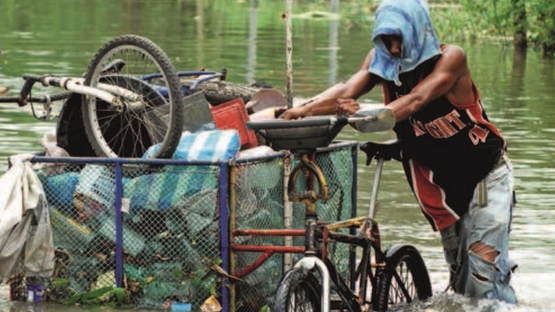Unusually high rainfall in many parts of the world is a result of climate change, scientists say. Since warmer air can hold more water, the rationale goes, increased temperatures will increase the chances of stronger rainfall events. And when surging seas combine with stronger rain, the outcome is almost certain: floods.
Floods are the most frequently occurring natural disasters, and south-east Asia is particularly vulnerable. Climate change and variability are expected to bring about increased typhoon activities, rising sea levels and off-season monsoon rains in south-east Asia and other regions. These can cause devastating floods in countries like Cambodia, Laos, Pakistan, the Philippines, Thailand and Viet Nam.
For the residents of these countries who have survived the ravages of major floods, the road to recovery can be long and arduous. As the flood water recedes, they have to contend with new forms of flood: floods of concern and worries as to how to rebuild their houses, their lives and their cities. Governments, too, face huge challenges in rebuilding roads, public buildings, infrastructure and natural resources destroyed or polluted by the flood.
Rebuilding with scientific tools
A flood-stricken area must be restored before any development can be carried out. To this effect, the Joint FAO/IAEA Division of Nuclear Techniques in Food and Agriculture has launched large-scale multi-year projects in the region to help flood-affected countries to rebuild key resources and put in place measures that will lessen the impact of future floods.
These projects will use nuclear and isotopic techniques to identify an integrated solution to flood management, both before and after major flooding events (see box).
“Use of nuclear techniques will enable us to better track sources and pathways of diseases, nutrients, soil and water movement in the flood-affected areas,” said Raymond Sucgang, a senior science research specialist at the Philippine Nuclear Research Institute.
“This knowledge will be highly valuable in helping the country establish an integrated solution for flood management and rehabilitation based on sound scientific knowledge,” Sucgang added.
Experts from Australia and New Zealand recently visited the areas most affected by Super Typhoon Haiyan, which devastated the eastern seaboard of the Philippines in November 2013. The experts, working under an IAEA-supported project, have surveyed the affected areas and proposed nuclear techniques to use in identifying sediment sources, as well as training local counterparts in the use of isotopic and other techniques, Sucgang explained.
Local officials want to assess the changes in circulation, dynamics and quality of groundwater in Tacloban City caused by Typhoon Haiyan, to study the dynamics of the area’s natural recovery process, and to try to accelerate the remediation of the affected environment.
There is a widespread belief that flooding brought about by the accompanying storm surge might have contaminated the city’s groundwater and aquifer systems with decaying organic matter, cadavers and seawater. Surrounding fields may also no longer be fit for agriculture due to the presence of salt and flood-borne contaminants in the soil.
Local authorities, however, need access to reliable and effective scientific information on which to base their plans, policies, actions and mitigation strategies. Nuclear techniques are powerful tools that can unearth this much-needed information.
A regional approach to flood management
The work in the Philippines will serve as a pilot for assistance to other countries in the region.
The overall goal is to improve the capacity of Asian countries to use nuclear techniques in developing agricultural systems that are resilient and can adapt to flooding events, said Lee Kheng Heng, Head of the Soil and Water Management and Crop Nutrition Section at the Joint FAO/IAEA Division of Nuclear Techniques in Food and Agriculture. Efficient use of nuclear and isotopic techniques will help them generate flood-tolerant crops, improve soil-water nutrient management practices for flood rehabilitation and adaptation, optimize the use of local feed resources and rapid diagnosis of animal diseases, perform comprehensive water resource assessments for forecasting potential floods, and develop strategies to exploit the potential of flood plains to absorb flood water, she explained.
Planned activities include a training course at the IAEA’s laboratories on early detection of animal diseases in a post-flooding environment with an emphasis on waterborne and vector-borne diseases; a training course in China on the use of fallout radionuclide and compound specific stable isotopes and other relevant techniques in flood-risk mitigation and post-flood rehabilitation efforts in Asia; and a regional training course in Thailand on the use of isotope and geochemical applications in flood-risk mitigation. In addition, Argonne National Laboratory in the United States is funding a workshop for decision makers to raise awareness of the importance of flood management and mitigation.
“Together, these activities will help strengthen Member States’ capacities in using nuclear techniques in combination with conventional approaches and strengthen national and regional collaboration in flood management. They will also ensure that scientific knowledge is available to them to forecast when the next flood may come, as well as its potential extent,” Lee Heng said.
Use of nuclear techniques will enable us to better track sources and pathways of diseases, nutrients, soil and water movement in the flood-affected areas.


